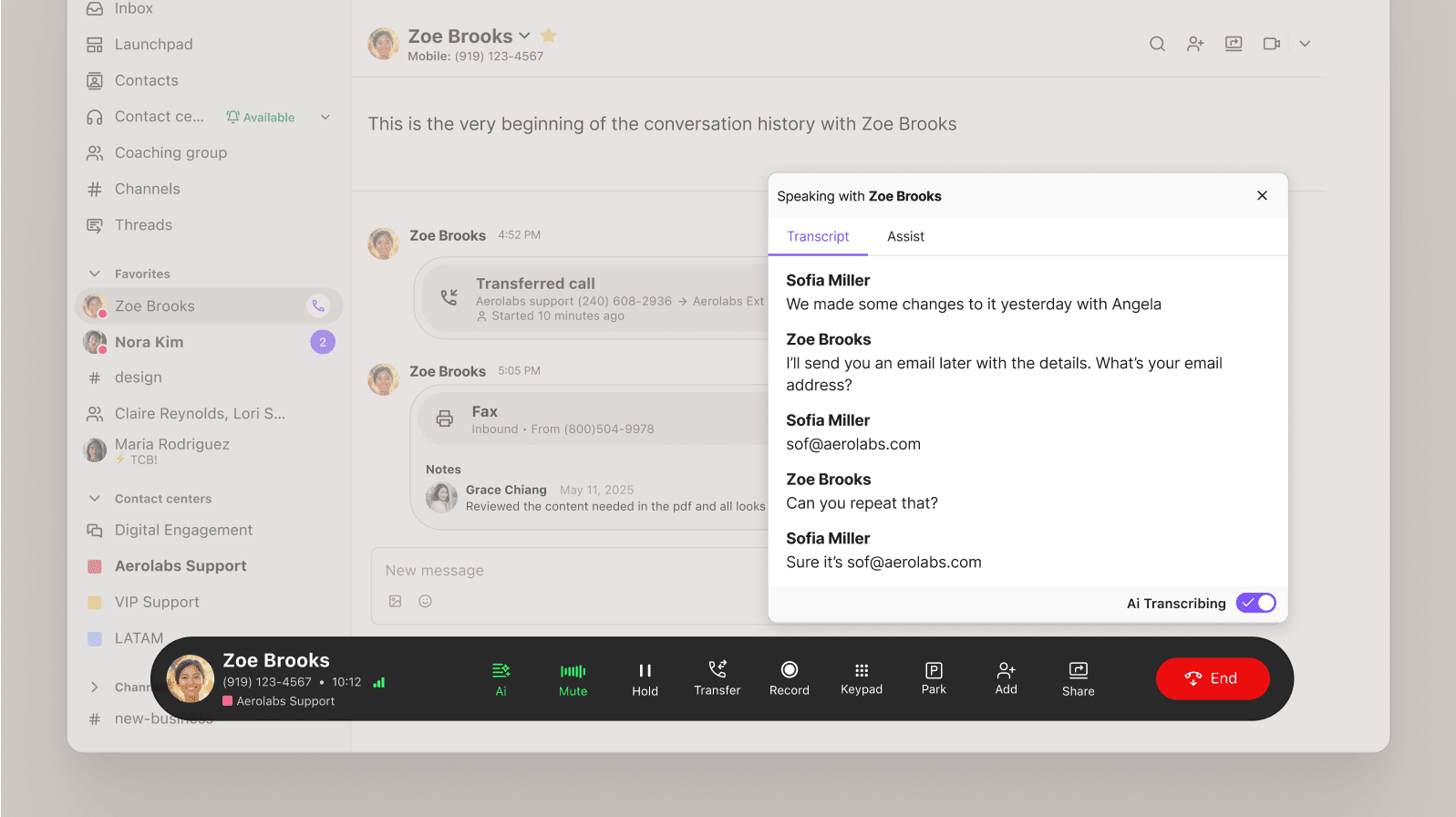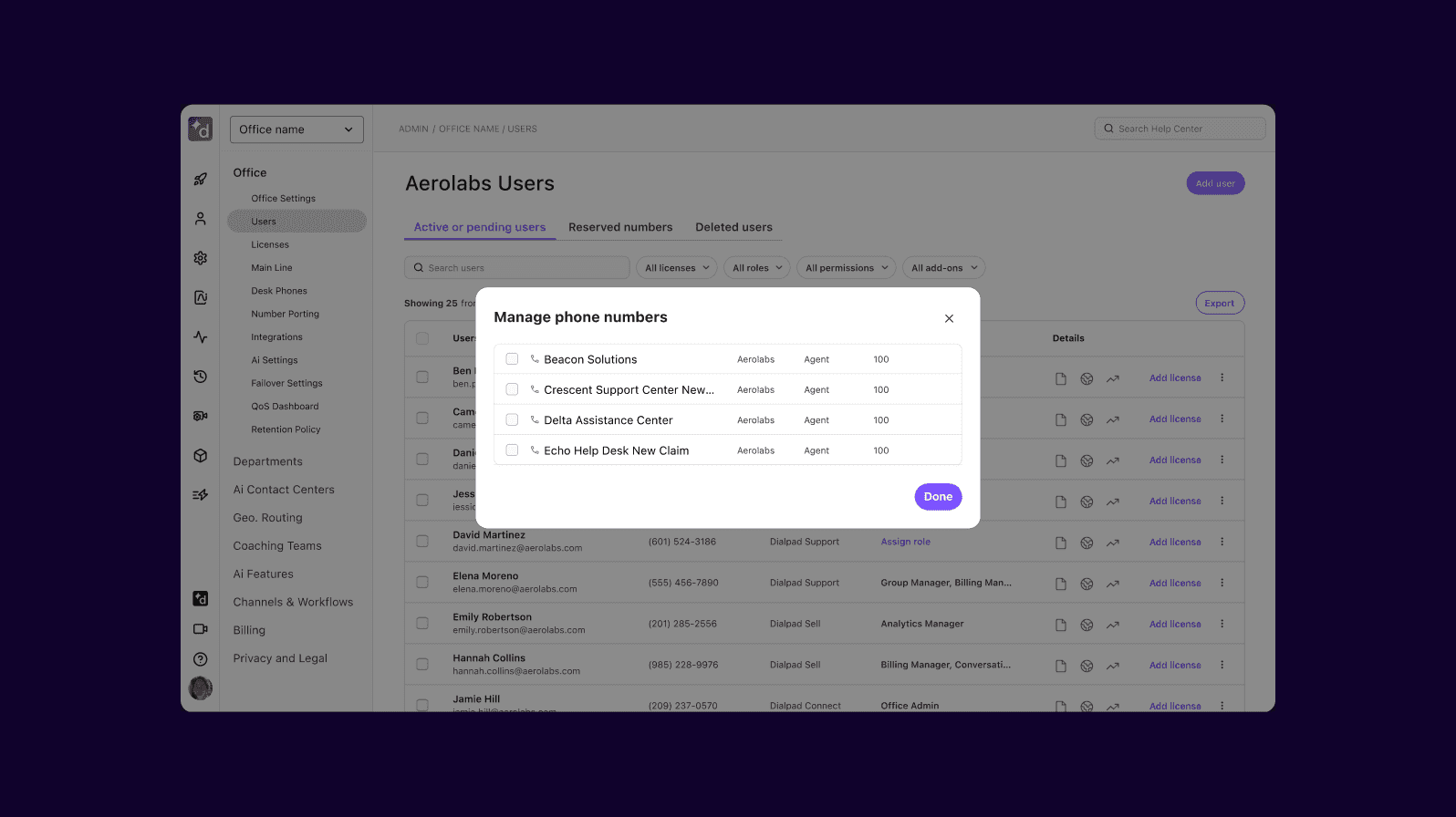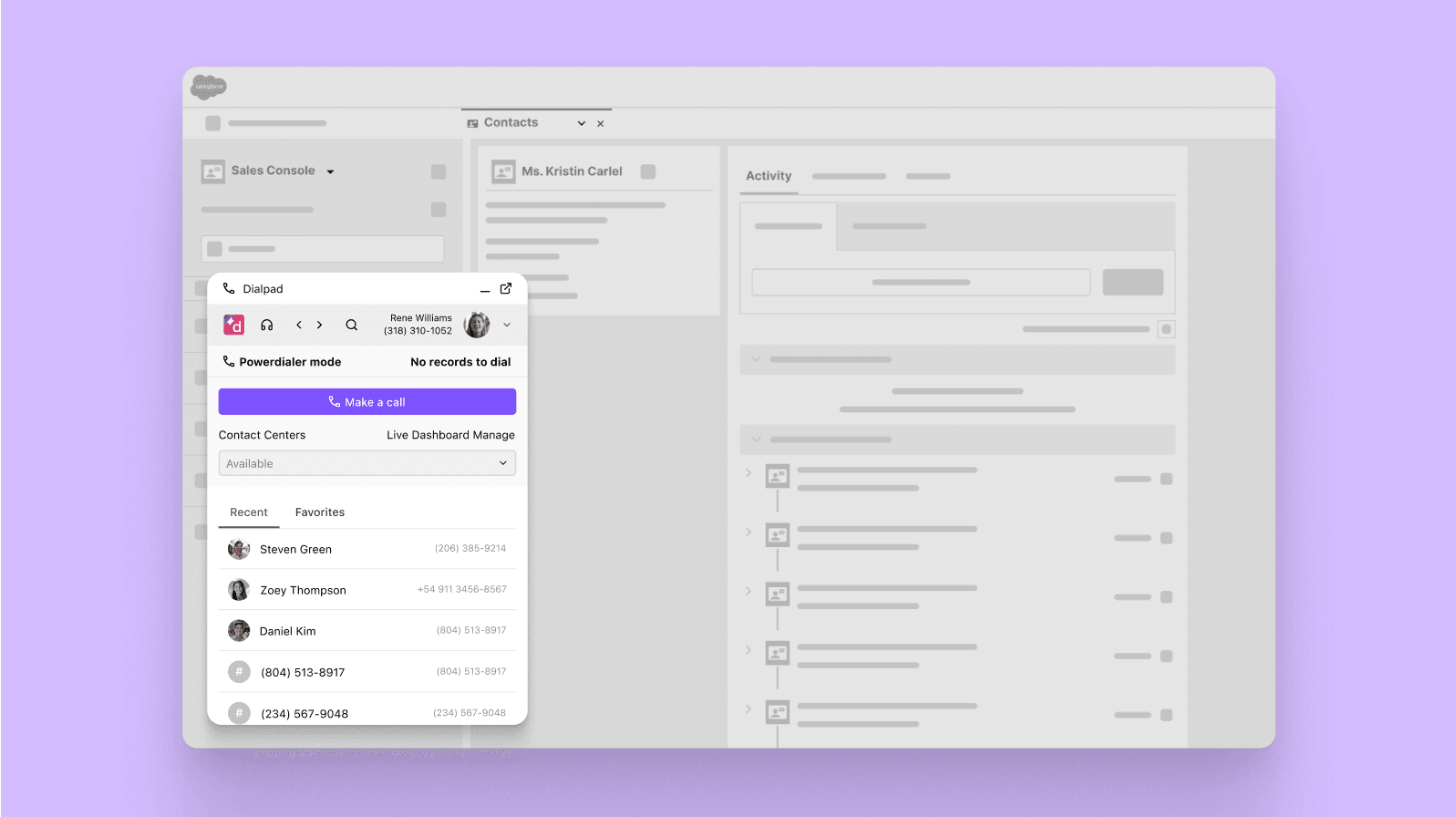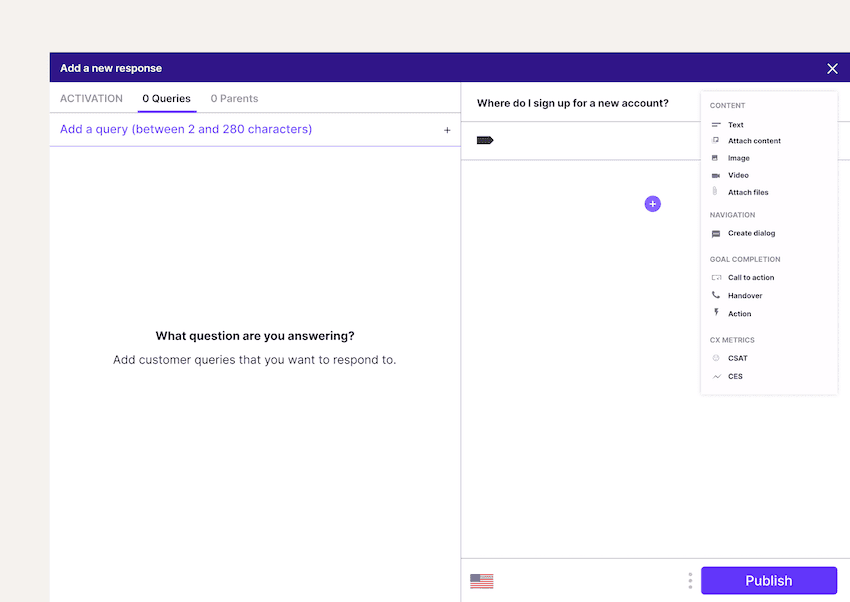SaaS vs on-premises
What are the differences between SaaS and on-premises solutions? Which should businesses consider, depending on cost, flexibility, and scalability? Keep reading to learn more. Or, if you're interested in an AI-powered SaaS solution, book a product tour of Dialpad!

The cloud has been a game-changer for businesses of all sizes. It provides flexibility, scalability, and cost-savings that were once out of reach unless your company had very deep pockets.
But of course, there are advantages and disadvantages to both SaaS (Software as a Service) and on-premises solutions. In this guide, we’ll weigh the pros and cons of each and look at some case studies from businesses in different industries that were considering this very question.
But first, let’s get the basics out of the way.
What is SaaS?
SaaS, or Software as a Service, is a type of delivery model for software that you pay for on a subscription basis. There are minimal upfront costs—generally, you just choose a monthly or annual plan for whatever SaaS application you’re interested in, and you’re ready to go.
Instead of installing software from a CD like we used to do, today we can use SaaS applications by downloading a desktop or mobile app, or even by logging into our accounts on a web browser.
SaaS applications are typically owned and operated by the SaaS vendor or service provider, which means they have their own data centers and take care of all maintenance and new feature upgrades.
👉 On “SaaS software”:
You’ll sometimes hear people say “SaaS software,” which is kind of redundant since SaaS stands for “Software as a Service.” (Like saying “chai tea" or "PIN number.") Just SaaS is fine!
What is on-premises?
On-premises software, on the other hand, typically requires hardware and things like server closets, which all need to be stored in-house in your office spaces.
Historically, this has been the most common way businesses acquired and used software. You’d purchase a software license, usually for a hefty one-time fee, then install the software on your computers. In these cases, you’d also be responsible for managing the infrastructure, including servers, storage, networking, and security.
If it sounds like a lot of work, it is—businesses would need pretty significant internal resources and IT departments to manage on-prem solutions.
On-premises vs SaaS: 6 core differences, with case studies
There are many types of software applications that have both on-prem and SaaS counterparts, but for these differences listed below, we’ll look at a business communications platform as an example to compare what a SaaS vs on-premises setup would look like.
1. Costs
On-premises solutions require a higher upfront investment, because businesses have to purchase the software and hardware, and pay for setup and ongoing maintenance. SaaS solutions are subscription-based, so businesses only have to pay for what they use, and there are no maintenance costs. Usually, there aren’t setup costs with cloud solutions unless you have particularly complex requirements, but this is rarely the case.
Other costs to consider are things like data storage capacity and how much that would cost. With on-prem solutions, you’d have to pay for additional capacity, whereas a SaaS product like Dialpad’s cloud communications and customer engagement platform comes with unlimited cloud call recordings.
From a telephony perspective, as an example, Dialpad’s platform makes local and international calling very affordable—even the least expensive plan, at $15 per user per month, includes unlimited calling in the US and Canada along with business communications essentials like call routing, real-time transcriptions, and more:

🔎 Case study:
See how Xero saved $500,000 a year by moving to a SaaS collaboration platform.
Implementation and set-up
On-premises solutions can be complex to set up and implement, because businesses have to configure the software and hardware themselves. SaaS solutions, on the other hand, don’t really require any setup at all because all you need to do is download an app to your computer or cell phone, and you’re good to go.
With on-premises software, you might need server closets, additional office space, and so on—and it can be both time-consuming and more costly to get up and running.
Dialpad, for example, lets you add users and manage phone numbers, right from your online dashboard:

🔎 Case study:
See how Education First sets up new call centers in just 10 minutes using Dialpad’s cloud customer engagement platform—and why their Communications System Manager said, "With Dialpad, we can set up a new call center in 10 minutes from anywhere. We have the flexibility to manage our call center on our own, and it’s easy."
Third-party integrations
Another key difference between on-prem and SaaS applications is that SaaS solutions are much easier to integrate with other cloud services and business software.
Depending on your business needs, you could be using general productivity tools like Google Workspace, CRMs like Salesforce, ticketing software, and so on.
With SaaS applications, you’d typically get a much wider selection of native integrations—and even if there isn’t a native integration with a tool you’re using, you could build one with APIs.
This may be possible with some on-prem solutions, but it would be a much more time-consuming and expensive process.
Dialpad, for example, has a range of contact center integrations and other automations with tools like Salesforce, HubSpot, Microsoft Teams, Google Workspace, and more. Its CRM integrations embed dialing functionality right inside the CRM so that support agents and sales reps don’t have to toggle between different tools constantly, and also auto-logs activities for them:

🔎 Case study:
See how Guidesley’s sales team closes deals efficiently with a SaaS communications platform that integrates with their CRM, HubSpot.
I absolutely love that it syncs with HubSpot. It pre-populates the caller’s information so I know who’s calling if they are in our CRM database, and I can log calls easily and automatically, keeping a solid record of every communication.
Tarrin Miller
Sales Representative at Guidesly
Scalability
If you’re running a growing business, this is probably one of the most important differences between SaaS and on-prem solutions.
Between the two, on-premises solutions are much more difficult to scale, because businesses have to constantly purchase additional hardware as their needs grow. With a SaaS model, you can easily scale upand down to meet changing needs and seasonality—without the need to make any changes to any physical infrastructure or increase your IT team to support this growth.
From a scalability perspective, SaaS solutions are more convenient—you’d simply adjust your subscription plan and add more users or go up a tier.
If you needed to, say, hire an extra hundred agents in your airline or ecommerce contact center to handle the busy holiday period, that would be much easier to do with a SaaS solution than an on-premises solution. You can add those licenses remotely and not need to ship out a ton of hardware beyond a laptop for your remote workers.
Dialpad, for example, has a unique dual cloud architecture design (which uses Google Cloud Platform’s public cloud) with redundancies and data centers worldwide to ensure that our customers can both scale up and down easily, and also have reliable call quality around the world. Again, not possible with on-prem solutions.
🔎 Case study:
See how Fenway Health switched over 600 call center agents to remote work with no downtime.
Compliance and security requirements
Now, let’s look at data security and compliance.
On-premises solutions do give you complete control over your data, and this has always been one of the most-touted advantages that on-prem has over SaaS applications.
And while that’s true, this also means that you are responsible for your on-premises software and security, which can be a challenge for organizations that don’t have the resources or expertise to invest in robust security controls.
And today, many SaaS providers have stringent security measures and can help businesses and organizations maintain compliance with HIPAA, GDPR, and more.
Not only that, they also have redundancies built into the system so that even if one data center goes down, the backups will allow operations to continue as normal without any noticeable difference.
Plus, SaaS applications are updated more frequently than on-premises applications, which means that security vulnerabilities are patched more quickly. The economies of scale are heavily in favor of cloud providers here. (Learn more about making a business continuity plan.)
🔎 Case study:
When you’re thinking of security and disaster recovery, don’t forget about the physical risks of having everything on-premises. For example, natural disasters—and in The Second City’s case, fires. Learn how they recovered after a devastating fire and moved their communications to the cloud.
Upgrades
With on-premises solutions, businesses have to wait for the vendor to release upgrades before they can install them. And because on-prem solutions tend to be more slow-moving in terms of innovation, it’s not uncommon to have to wait months or years for new functionality.
With SaaS solutions, upgrades are automatically applied and you always have access to the latest version of the software. In Dialpad’s case, new functionality gets rolled out pretty much every quarter.
For example, we recently rolled out new AI functionality that lets distributed contact center teams manage customer conversations across voice, video, and digital and social media channels—all from a single app with a beautiful user experience:

🔎 Further reading:
Learn more about on-prem vs cloud.
Is SaaS or on-prem right for you?
There are a lot of factors to consider when deciding whether to deploy a SaaS solution vs an on-premises solution.
Many of the conventional benefits of on-premises deployment for companies with complex IT infrastructure are no longer true today, with SaaS solutions being much more flexible, cost-effective, and yes, even comparably secure.
If you’re rethinking your business processes and considering to move from your on-prem communications platform or phone system, Dialpad’s SaaS solution gives you a UCaaS (Unified Communications as a Service) platform with all the channels you need—phone calls, video meetings, SMS/MMS + team messaging, and even contact center functionality—in one cohesive package, with minimal upfront costs.
Try it out!
See how Dialpad's SaaS communications solution works
Get a personal walkthrough from our team, or take a self-guided interactive tour of the app!
